Refining Fire–Climate Relationship Methodologies: Southern California
Abstract
:1. Introduction
2. Study Area
3. Data and Methods
3.1. Development of Annual Fire Severity Index
3.1.1. Wildfire Data
3.1.2. ERC Data
3.1.3. AFSI Calculation Methodology
3.2. Statistical Analysis of AFSI Fire–Climate Relationships
3.2.1. Atmospheric Predictor Data
3.2.2. Singular Spectrum Analysis
4. Results
4.1. SSA Decomposition
4.1.1. Component 0
4.1.2. Component 1–2
4.1.3. Component 3–4
4.1.4. Component 5–6
5. Discussion and Conclusions
Author Contributions
Funding
Data Availability Statement
Conflicts of Interest
References
- Syphard, A.D.; Radeloff, V.C.; Keeley, J.E.; Hawbaker, T.J.; Clayton, M.K.; Stewart, S.I.; Hammer, R.B. Human Influence on California Fire Regimes. Ecol. Appl. 2007, 17, 1388–1402. [Google Scholar] [CrossRef]
- Riley, K.L.; Abatzoglou, J.T.; Grenfell, I.C.; Klene, A.E.; Heinsch, F.A. The Relationship of Large Fire Occurrence with Drought and Fire Danger Indices in the Western USA, 1984–2008: The Role of Temporal Scale. Int. J. Wildland Fire 2013, 22, 894. [Google Scholar] [CrossRef]
- Abatzoglou, J.T.; Kolden, C.A. Relationships between Climate and Macroscale Area Burned in the Western United States. Int. J. Wildland Fire 2013, 22, 1003. [Google Scholar] [CrossRef]
- Swetnam, T.W. Fire History and Climate Change in Giant Sequoia Groves. Science 1993, 262, 885–889. [Google Scholar] [CrossRef] [PubMed]
- Trouet, V.; Taylor, A.H.; Carleton, A.M.; Skinner, C.N. Interannual Variations in Fire Weather, Fire Extent, and Synoptic-Scale Circulation Patterns in Northern California and Oregon. Theor. Appl. Clim. 2009, 95, 349–360. [Google Scholar] [CrossRef] [Green Version]
- Westerling, A.L.; Swetnam, T.W. Interannual to Decadal Drought and Wildfire in the Western United States. Eos Trans. AGU 2003, 84, 545. [Google Scholar] [CrossRef]
- Kitzberger, T.; Brown, P.M.; Heyerdahl, E.K.; Swetnam, T.W.; Veblen, T.T. Contingent Pacific–Atlantic Ocean Influence on Multicentury Wildfire Synchrony over Western North America. Proc. Natl. Acad. Sci. USA 2007, 104, 543–548. [Google Scholar] [CrossRef]
- McCabe, G.J.; Palecki, M.A.; Betancourt, J.L. Pacific and Atlantic Ocean Influences on Multidecadal Drought Frequency in the United States. Proc. Natl. Acad. Sci. USA 2004, 101, 4136–4141. [Google Scholar] [CrossRef]
- Brown, D.P.; Comrie, A.C. A Winter Precipitation ‘Dipole’ in the Western United States Associated with Multidecadal ENSO Variability. Geophys. Res. Lett. 2004, 31, L09203.1–L09203.4. [Google Scholar] [CrossRef] [Green Version]
- Gershunov, A.; Barnett, T.P. Interdecadal Modulation of ENSO Teleconnections. Bull. Am. Meteor. Soc. 1998, 79, 2715–2725. [Google Scholar] [CrossRef]
- Keeley, J.E. Impact of Antecedent Climate on Fire Regimes in Coastal California. Int. J. Wildland Fire 2004, 13, 173. [Google Scholar] [CrossRef]
- Mantua, N.J.; Hare, S.R.; Zhang, Y.; Wallace, J.M.; Francis, R.C. A Pacific Interdecadal Climate Oscillation with Impacts on Salmon Production. Bull. Amer. Meteor. Soc. 1997, 78, 1069–1079. [Google Scholar] [CrossRef]
- McCabe, G.J.; Dettinger, M.D. Decadal Variations in the Strength of ENSO Teleconnections with Precipitation in the Western United States. Int. J. Climatol. 1999, 19, 1399–1410. [Google Scholar] [CrossRef]
- Trouet, V.; Taylor, A.H.; Carleton, A.M.; Skinner, C.N. Fire-Climate Interactions in Forests of the American Pacific Coast: Fire-Climate Interactions in Forests. Geophys. Res. Lett. 2006, 33, L18704. [Google Scholar] [CrossRef]
- Rolinski, T.; Capps, S.B.; Zhuang, W. Santa Ana Winds: A Descriptive Climatology. Weather Forecast. 2019, 34, 257–275. [Google Scholar] [CrossRef]
- Jin, Y.; Randerson, J.T.; Faivre, N.; Capps, S.; Hall, A.; Goulden, M.L. Contrasting Controls on Wildland Fires in Southern California during Periods with and without Santa Ana Winds: Controls on Southern California Fires. J. Geophys. Res. Biogeosci. 2014, 119, 432–450. [Google Scholar] [CrossRef] [Green Version]
- Westerling, A.L.; Cayan, D.R.; Brown, T.J.; Hall, B.L.; Riddle, L.G. Climate, Santa Ana Winds and Autumn Wildfires in Southern California. Eos Trans. AGU 2004, 85, 289. [Google Scholar] [CrossRef]
- Williams, A.P.; Gentine, P.; Moritz, M.A.; Roberts, D.A.; Abatzoglou, J.T. Effect of Reduced Summer Cloud Shading on Evaporative Demand and Wildfire in Coastal Southern California. Geophys. Res. Lett. 2018, 45, 5653–5662. [Google Scholar] [CrossRef]
- Keeley, J.; Hugh, S.; Fotheringham, C.J.; Janet, F.; Max, M. The 2007 Southern California Wildfires: Lessons in Complexity. J. For. 2009, 107, 287–296. [Google Scholar]
- Keeley, J.E.; Fotheringham, C.J.; Moritz, M.A. Lessons from the October 2003 Wildfires in Southern California. J. For. 2004, 102, 26–31. [Google Scholar] [CrossRef]
- Sapsis, D.; Martin, R. Fire, the Landscape, and Diversity: A Theoretical Framework for Managing Wildlands. In Proceedings of the 12th Conference on Fire and Forest Meteorology; Society of American Foresters, Jekyll Island, Georgia, 26–28 October 1993. [Google Scholar]
- Bradshaw, L.; Deeming, J.; Burgan, R.; Cohen, J. The 1978 National Fire-Danger Rating System: Technical Documentation; USDA Forest Service: Intermountain Forest and Range Experiment Station: Ogden, UT, USA, 1984.
- Cohen, J.; Deeming, J. The National Fire-Danger Rating System: Basic Equations; USDA Forest Service: Southwest Forest and Range Experiment Station: Berkeley, CA, USA, 1985.
- NWCG Glossary of Wildland Fire, PMS 205. Available online: https://www.nwcg.gov/glossary/a-z (accessed on 9 June 2023).
- Kolden, C.A.; Brown, T.J. Beyond Wildfire: Perspectives of Climate, Managed Fire and Policy in the USA. Int. J. Wildland Fire 2010, 19, 364. [Google Scholar] [CrossRef]
- Owen, G.; McLeod, J.D.; Kolden, C.A.; Ferguson, D.B.; Brown, T.J. Wildfire Management and Forecasting Fire Potential: The Roles of Climate Information and Social Networks in the Southwest United States. Weather Clim. Soc. 2012, 4, 90–102. [Google Scholar] [CrossRef] [Green Version]
- Urbieta, I.R.; Zavala, G.; Bedia, J.; Gutiérrez, J.M.; Miguel-Ayanz, J.S.; Camia, A.; Keeley, J.E.; Moreno, J.M. Fire Activity as a Function of Fire–Weather Seasonal Severity and Antecedent Climate across Spatial Scales in Southern Europe and Pacific Western USA. Environ. Res. Lett. 2015, 10, 114013. [Google Scholar] [CrossRef] [Green Version]
- Short, K. Spatial Wildfire Occurrence Data for the United States, 1992–2018 [FPA_FOD_20210617], 5th ed.; Forest Service Research Data Archive: Madison, WI, USA, 2021.
- Brown, T.J.; Hall, B.L.; Westerling, A.L. The Impact of Twenty-First Century Climate Change on Wildland Fire Danger in the Western United States: An Applications Perspective. Clim. Chang. 2004, 62, 365–388. [Google Scholar] [CrossRef]
- Huntington, J.L.; Hegewisch, K.C.; Daudert, B.; Morton, C.G.; Abatzoglou, J.T.; McEvoy, D.J.; Erickson, T. Climate Engine: Cloud Computing and Visualization of Climate and Remote Sensing Data for Advanced Natural Resource Monitoring and Process Understanding. Bull. Am. Meteorol. Soc. 2017, 98, 2397–2410. [Google Scholar] [CrossRef]
- Abatzoglou, J.T. Development of Gridded Surface Meteorological Data for Ecological Applications and Modelling. Int. J. Climatol. 2013, 33, 121–131. [Google Scholar] [CrossRef]
- Savitzky, A.; Golay, M.J. Smoothing and Differentiation of Data by Simplified Least Squares Procedures. Anal. Chem. 1964, 36, 1627–1639. [Google Scholar] [CrossRef]
- Schmid, M.; Rath, D.; Diebold, U. Why and How Savitzky–Golay Filters Should Be Replaced. ACS Meas. Au 2022, 2, 185–196. [Google Scholar] [CrossRef]
- National Oceanic and Atmospheric Administration Physical Sciences Laboratory. AMO (Atlantic Multidecadal Oscillation) Index 2022. Available online: https://psl.noaa.gov/data/correlation/amon.us.data (accessed on 10 July 2022).
- National Oceanic and Atmospheric Administration National Centers for Environmental Information. Pacific Decadal Oscillation (PDO) 2022. Available online: https://www.ncei.noaa.gov/pub/data/cmb/ersst/v5/index/ersst.v5.pdo.dat (accessed on 10 July 2022).
- National Oceanic and Atmospheric Administration Physical Sciences Laboratory. Oceanic Niño Index 2022. Available online: https://psl.noaa.gov/data/correlation/oni.data (accessed on 10 July 2022).
- Lindsey, R.U.S. Winter Temperatures for Every El Niño since 1950. Available online: https://www.climate.gov/news-features/featured-images/us-winter-temperatures-every-el-ni%C3%B1o-1950 (accessed on 9 June 2023).
- Hobbins, M.T.; Wood, A.; McEvoy, D.J.; Huntington, J.L.; Morton, C.; Anderson, M.; Hain, C. The Evaporative Demand Drought Index. Part I: Linking Drought Evolution to Variations in Evaporative Demand. J. Hydrometeorol. 2016, 17, 1745–1761. [Google Scholar] [CrossRef]
- McEvoy, D.J.; Huntington, J.L.; Hobbins, M.T.; Wood, A.; Morton, C.; Anderson, M.; Hain, C. The Evaporative Demand Drought Index. Part II: CONUS-Wide Assessment against Common Drought Indicators. J. Hydrometeorol. 2016, 17, 1763–1779. [Google Scholar] [CrossRef]
- Broomhead, D.S.; King, G.P. Extracting Qualitative Dynamics from Experimental Data. Phys. D Nonlinear Phenom. 1986, 20, 217–236. [Google Scholar] [CrossRef]
- Vautard, R.; Ghil, M. Singular Spectrum Analysis in Nonlinear Dynamics, with Applications to Paleoclimatic Time Series. Phys. D Nonlinear Phenom. 1989, 35, 395–424. [Google Scholar] [CrossRef]
- Vautard, R.; Yiou, P.; Ghil, M. Singular Spectrum Analysis: A Toolkit for Noisy and Chaotic Series. Phys. D 1992, 58, 126. [Google Scholar] [CrossRef]
- Elsner, J.B.; Tsonis, A.A. Singular Spectrum Analysis: A New Tool in Time Series Analysis; Springer: Boston, MA, USA, 1996; ISBN 978-1-4757-2514-8. [Google Scholar]
- Ghil, M.; Allen, M.R.; Dettinger, M.D.; Ide, K.; Kondrashov, D.; Mann, M.E.; Robertson, A.W.; Saunders, A.; Tian, Y.; Varadi, F.; et al. Advanced spectral methods for climatic time series: Climatic time series analysis. Rev. Geophys. 2002, 40, 3-1–3-41. [Google Scholar] [CrossRef] [Green Version]
- Yiou, P.; Sornette, D.; Ghil, M. Data-Adaptive Wavelets and Multi-Scale Singular-Spectrum Analysis. Phys. D Nonlinear Phenom. 2000, 142, 254–290. [Google Scholar] [CrossRef] [Green Version]
- Golyandina, N.; Nekrutkin, V.; Zhigljavsky, A. Analysis of Time Series Structure: SSA and Related Techniques; C&H/CRC Monographs on Statistics & Applied Probability; Chapman and Hall/CRC: Boca Raton, FL, USA, 2001; Volume 90, ISBN 978-1-58488-194-0. [Google Scholar]
- D’Arcy, J. Introducing SSA for Time Series Decomposition. Available online: https://www.kaggle.com/code/jdarcy/introducing-ssa-for-time-series-decomposition/notebook (accessed on 31 December 2017).
- Hessl, A.E.; McKenzie, D.; Schellhaas, R. Drought and pacific decadal oscillation linked to fire occurrence in the inland pacific northwest. Ecol. Appl. 2004, 14, 425–442. [Google Scholar] [CrossRef]
- Miller, J.D.; Safford, H.D.; Crimmins, M.; Thode, A.E. Quantitative Evidence for Increasing Forest Fire Severity in the Sierra Nevada and Southern Cascade Mountains, California and Nevada, USA. Ecosystems 2009, 12, 16–32. [Google Scholar] [CrossRef]
- Wyatt, M.G.; Kravtsov, S.; Tsonis, A.A. Atlantic Multidecadal Oscillation and Northern Hemisphere’s Climate Variability. Clim. Dyn. 2012, 38, 929–949. [Google Scholar] [CrossRef]
- Hidalgo, H.G. Climate Precursors of Multidecadal Drought Variability in the Western United States: Climate precursors of drought variability. Water Resour. Res. 2004, 40, W12504. [Google Scholar] [CrossRef] [Green Version]
- Hu, Q.; Feng, S.; Oglesby, R.J. Variations in North American Summer Precipitation Driven by the Atlantic Multidecadal Oscillation. J. Clim. 2011, 24, 5555–5570. [Google Scholar] [CrossRef] [Green Version]
- Beverly, J.L.; Flannigan, M.D.; Stocks, B.J.; Bothwell, P. The Association between Northern Hemisphere Climate Patterns and Interannual Variability in Canadian Wildfire Activity. Can. J. For. Res. 2011, 41, 2193–2201. [Google Scholar] [CrossRef] [Green Version]
- Mo, K.C.; Schemm, J.-K.E.; Yoo, S.-H. Influence of ENSO and the Atlantic Multidecadal Oscillation on Drought over the United States. J. Clim. 2009, 22, 5962–5982. [Google Scholar] [CrossRef] [Green Version]
- Prein, A.F.; Holland, G.J.; Rasmussen, R.M.; Clark, M.P.; Tye, M.R. Running Dry: The U.S. Southwest’s Drift into a Drier Climate State. Geophys. Res. Lett. 2016, 43, 1272–1279. [Google Scholar] [CrossRef]
- Climate and Atmospheric Indicators. Available online: https://www.fisheries.noaa.gov/west-coast/science-data/climate-and-atmospheric-indicators (accessed on 9 June 2023).
- Kitzberger, T.; Swetnam, T.W.; Veblen, T.T. Inter-Hemispheric Synchrony of Forest Fires and the El Niño-Southern Oscillation: ENSO-Teleconnected Fire Regimes. Glob. Ecol. Biogeogr. 2001, 10, 315–326. [Google Scholar] [CrossRef] [Green Version]
- Geng, X.; Zhang, W.; Jin, F.-F.; Stuecker, M.F.; Levine, A.F.Z. Modulation of the Relationship between ENSO and Its Combination Mode by the Atlantic Multidecadal Oscillation. J. Clim. 2020, 33, 4679–4695. [Google Scholar] [CrossRef]
- Swanson, K.L.; Tsonis, A.A. Has the Climate Recently Shifted? Geophys. Res. Lett. 2009, 36, L06711. [Google Scholar] [CrossRef] [Green Version]
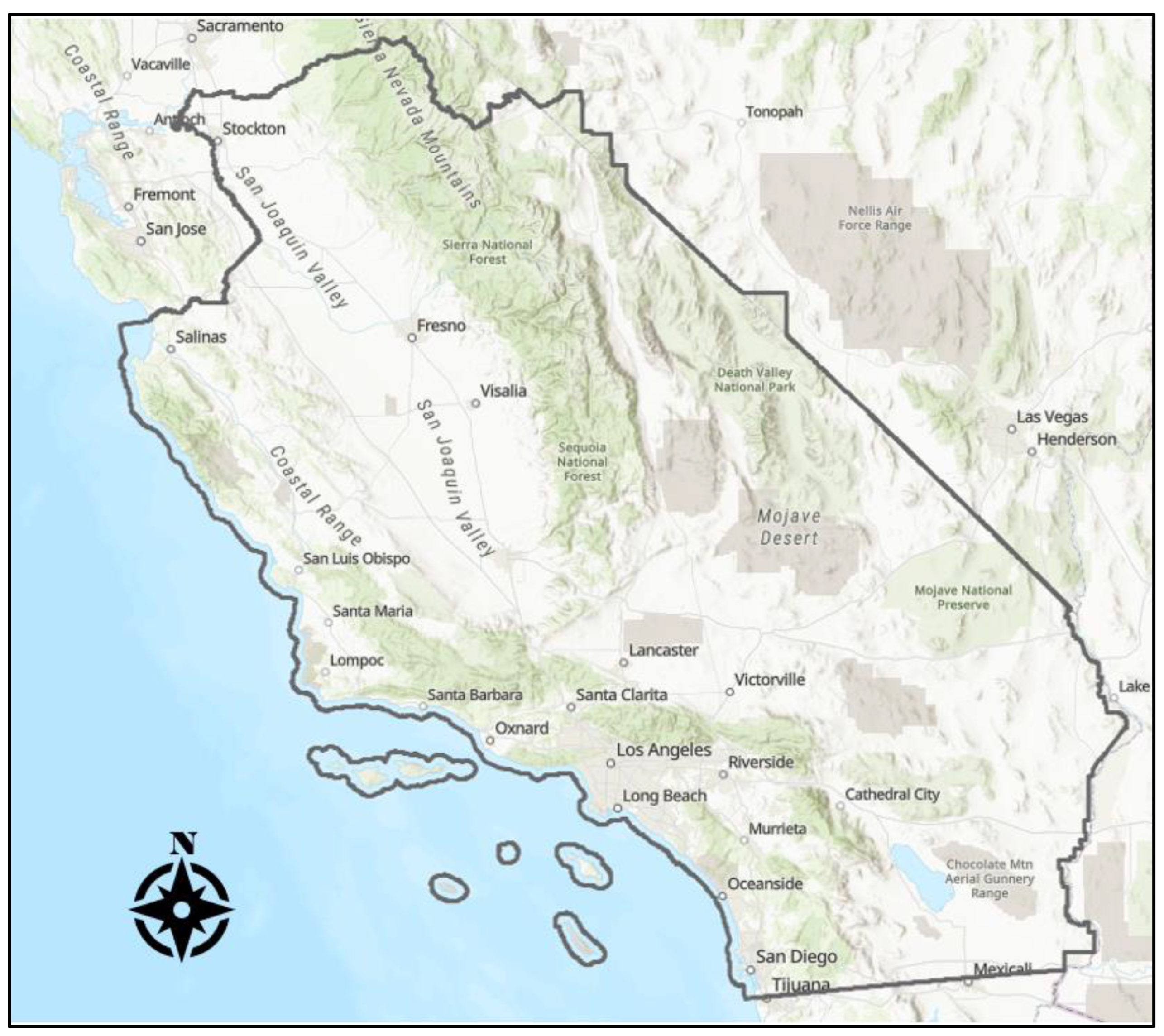
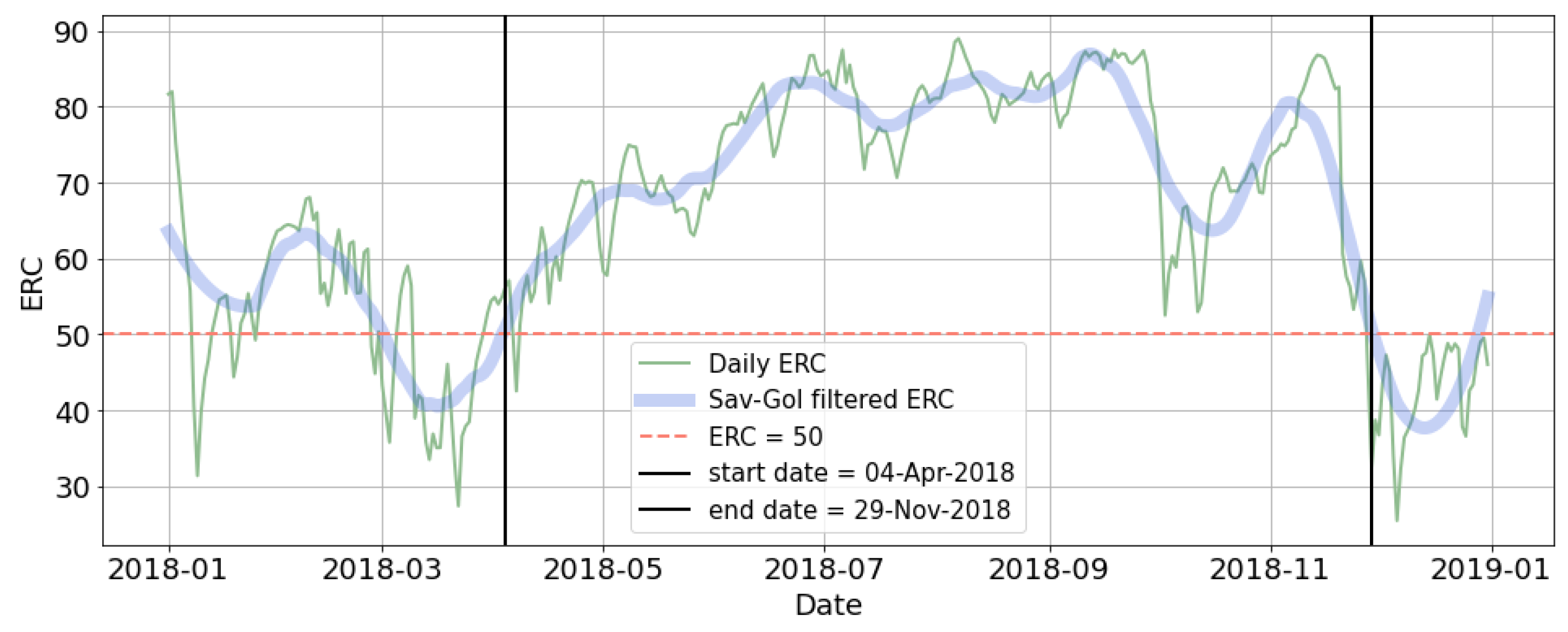
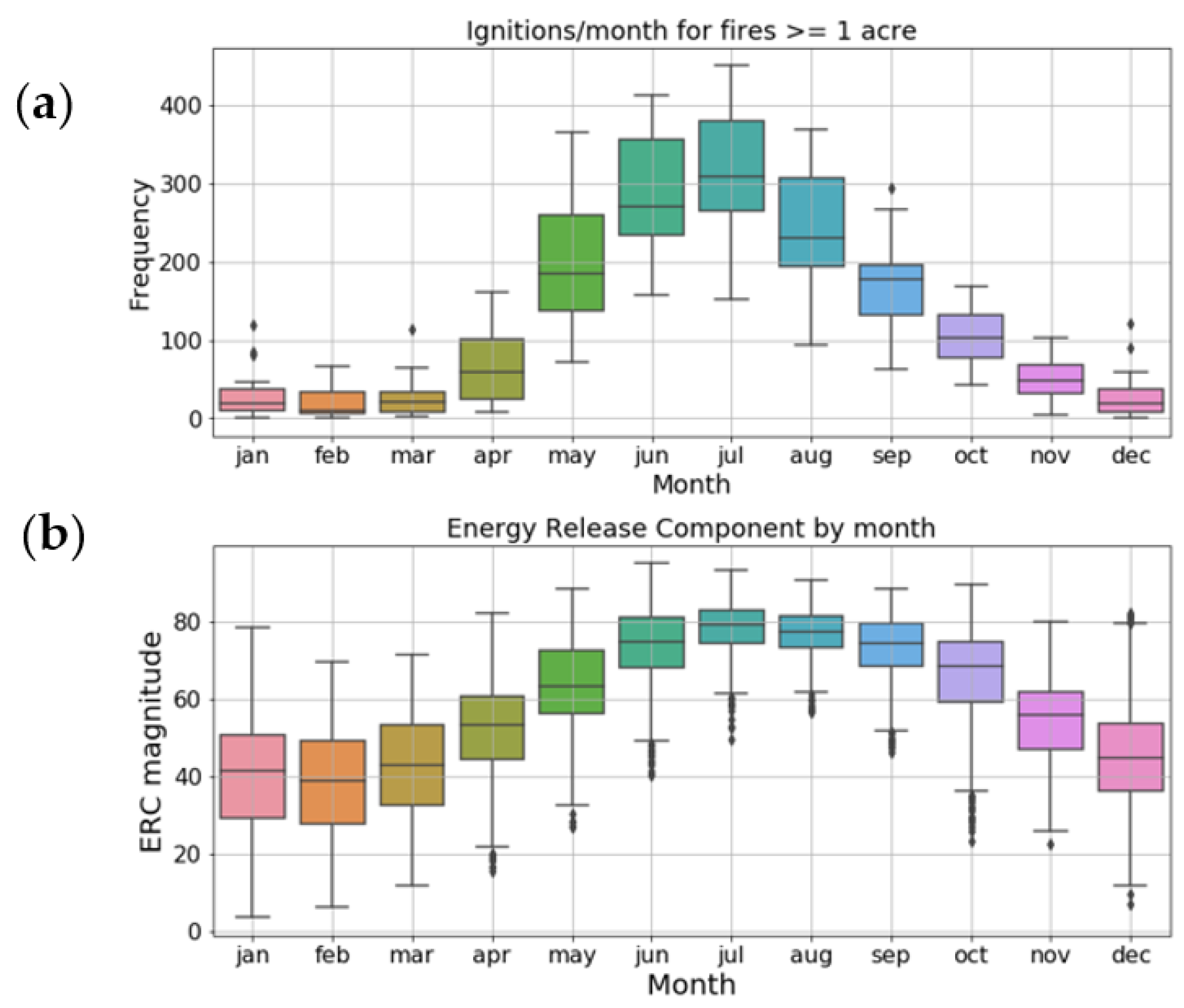
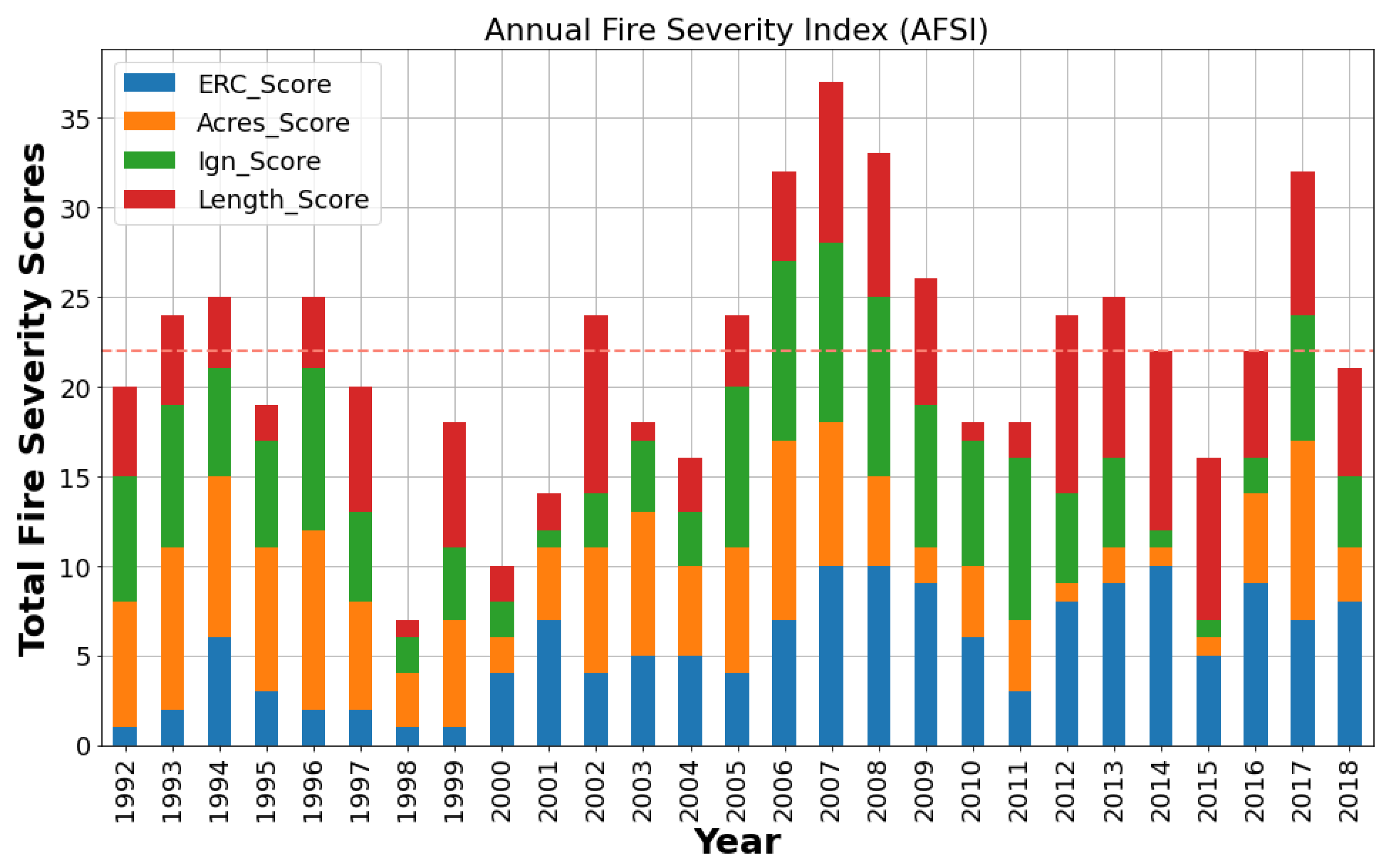
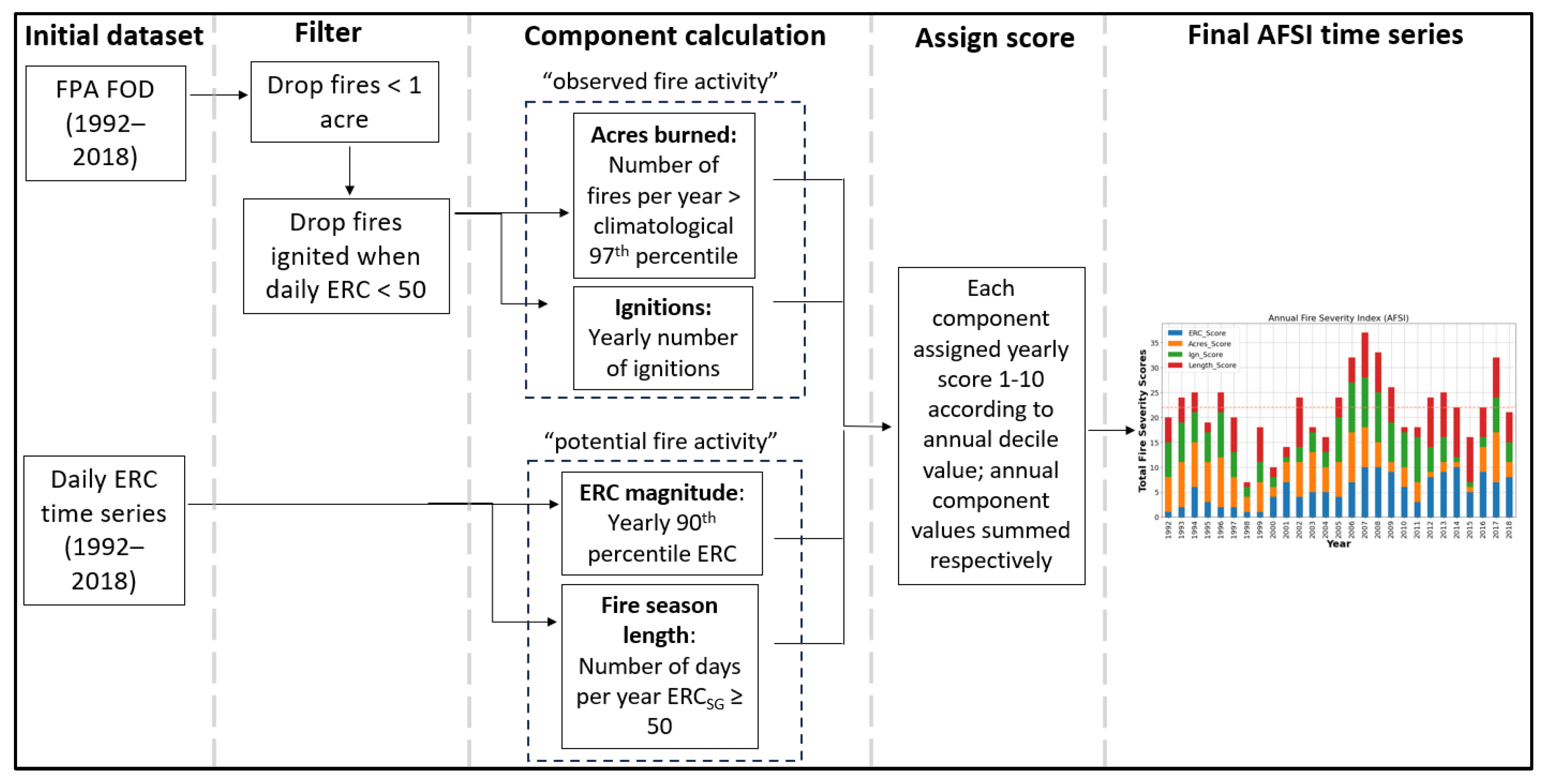
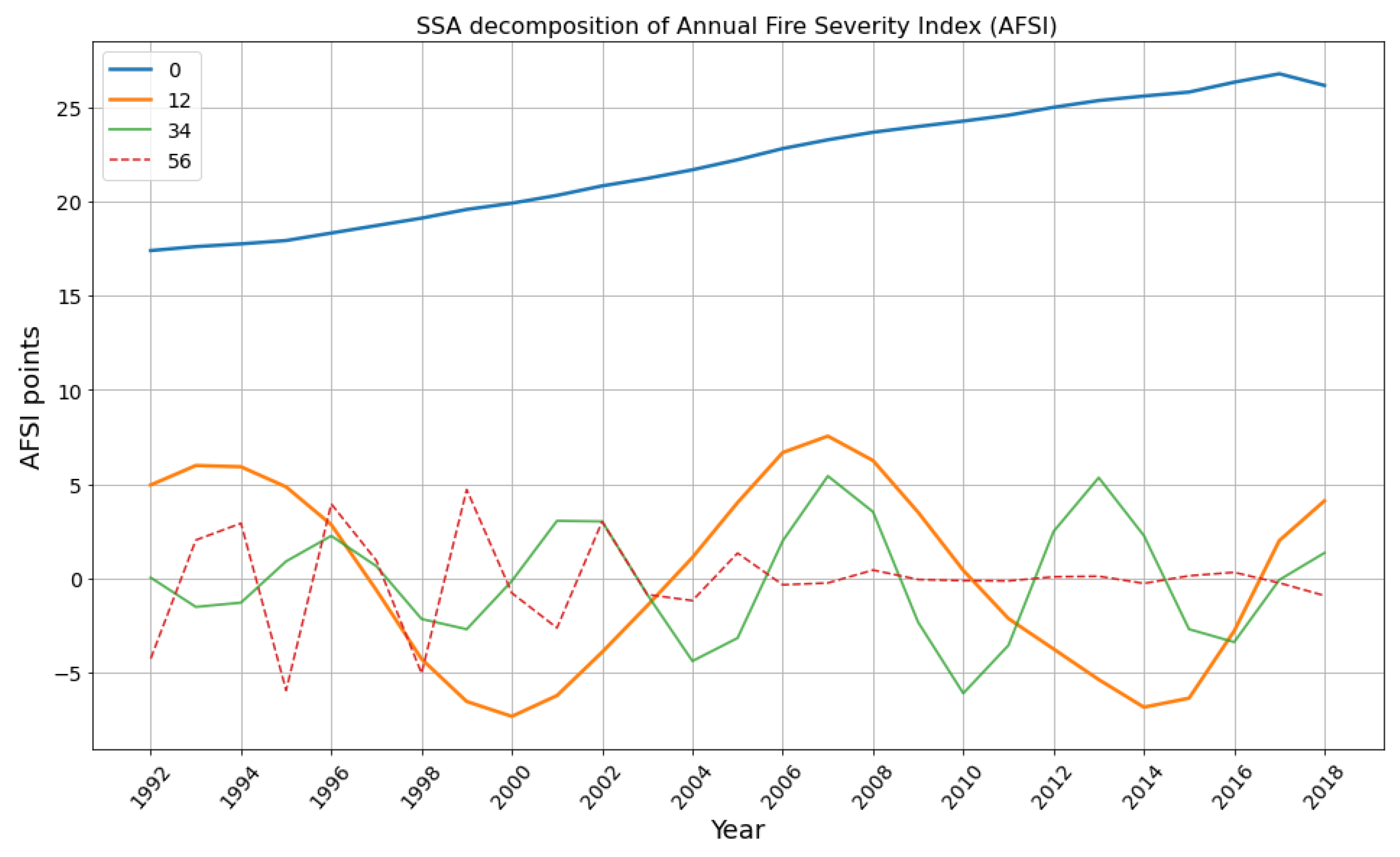
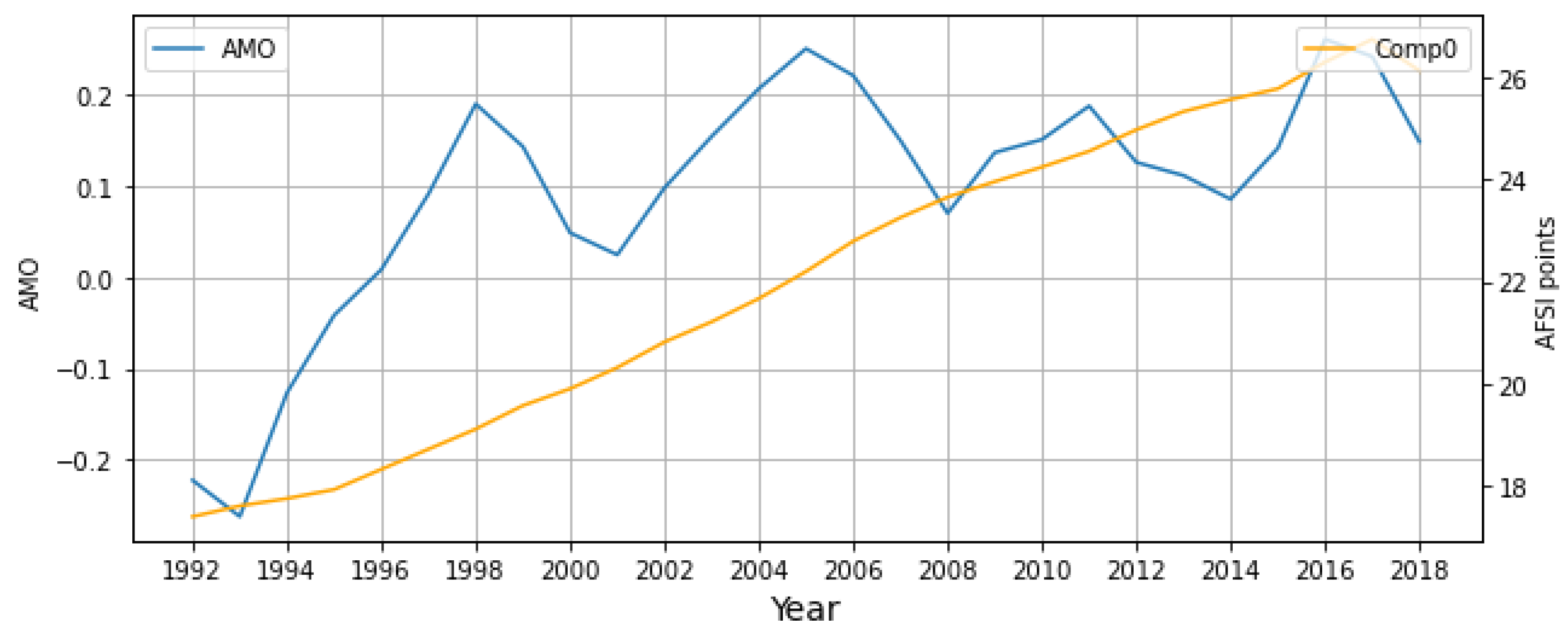


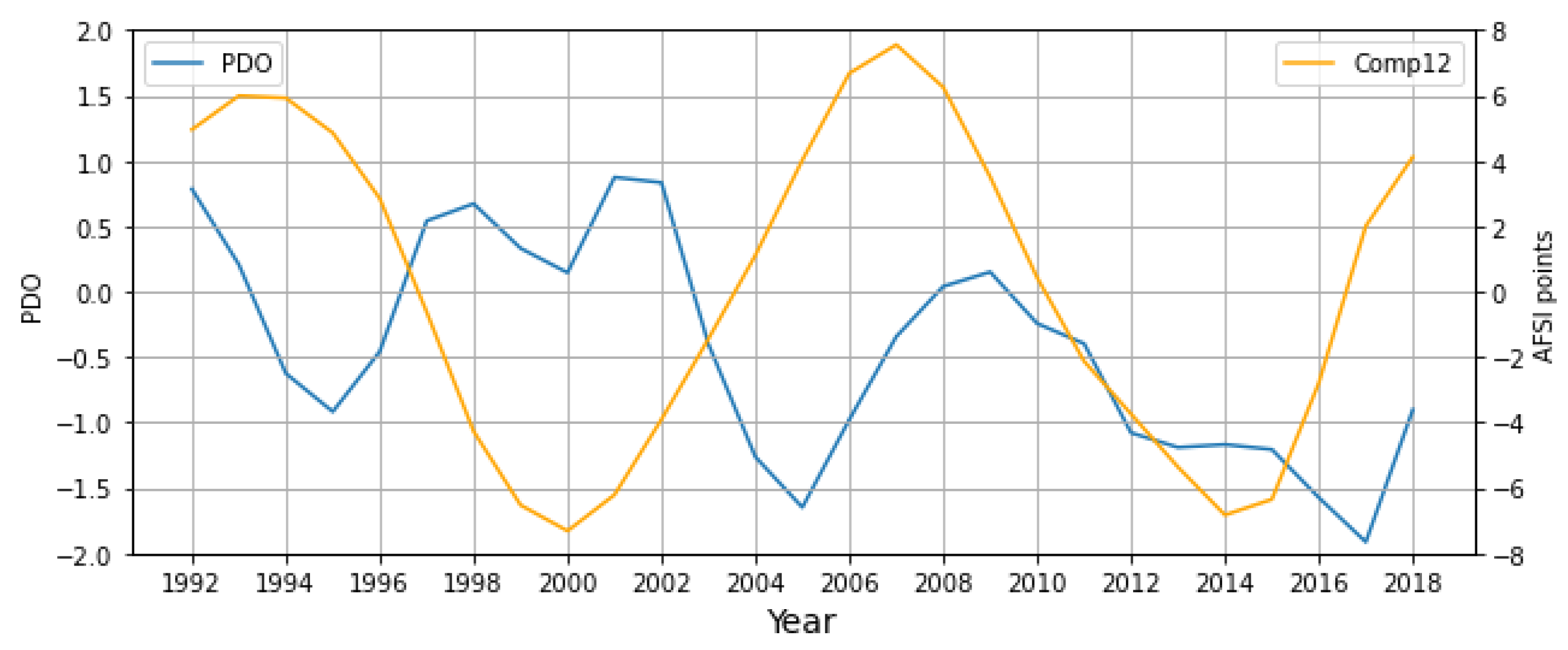
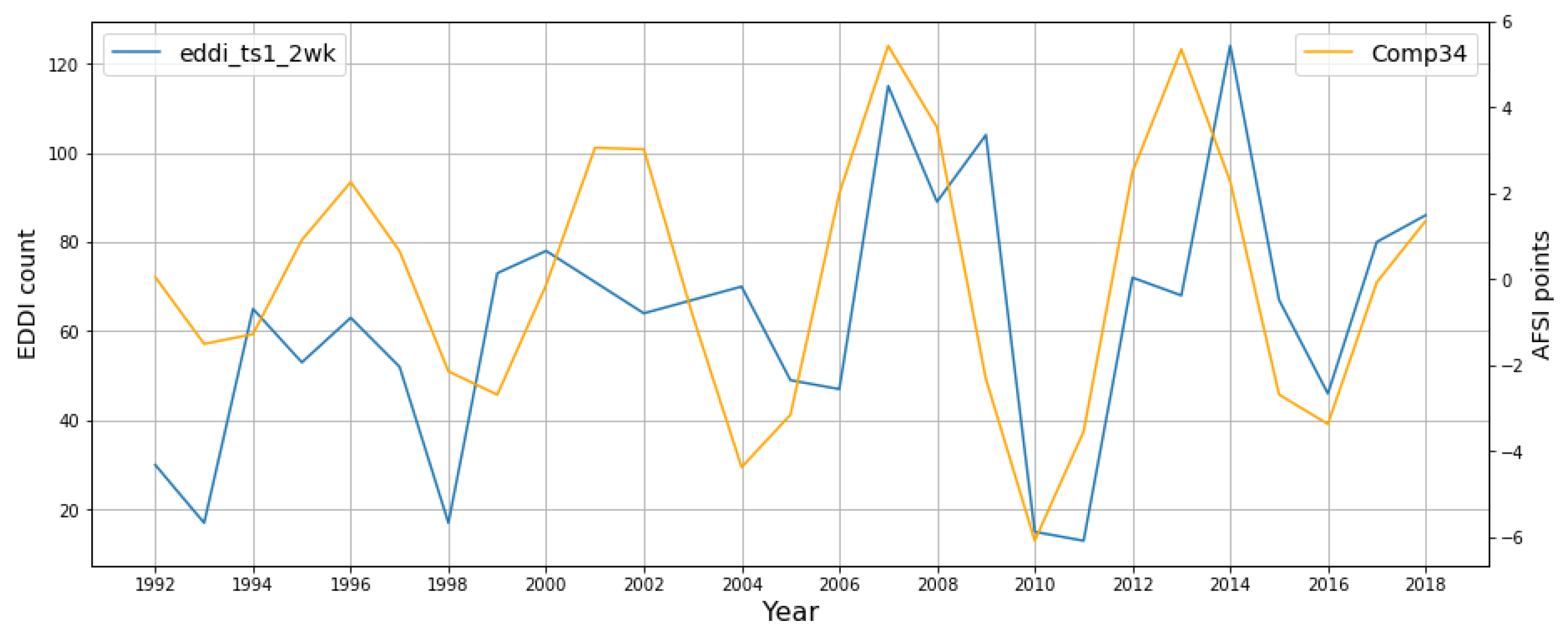
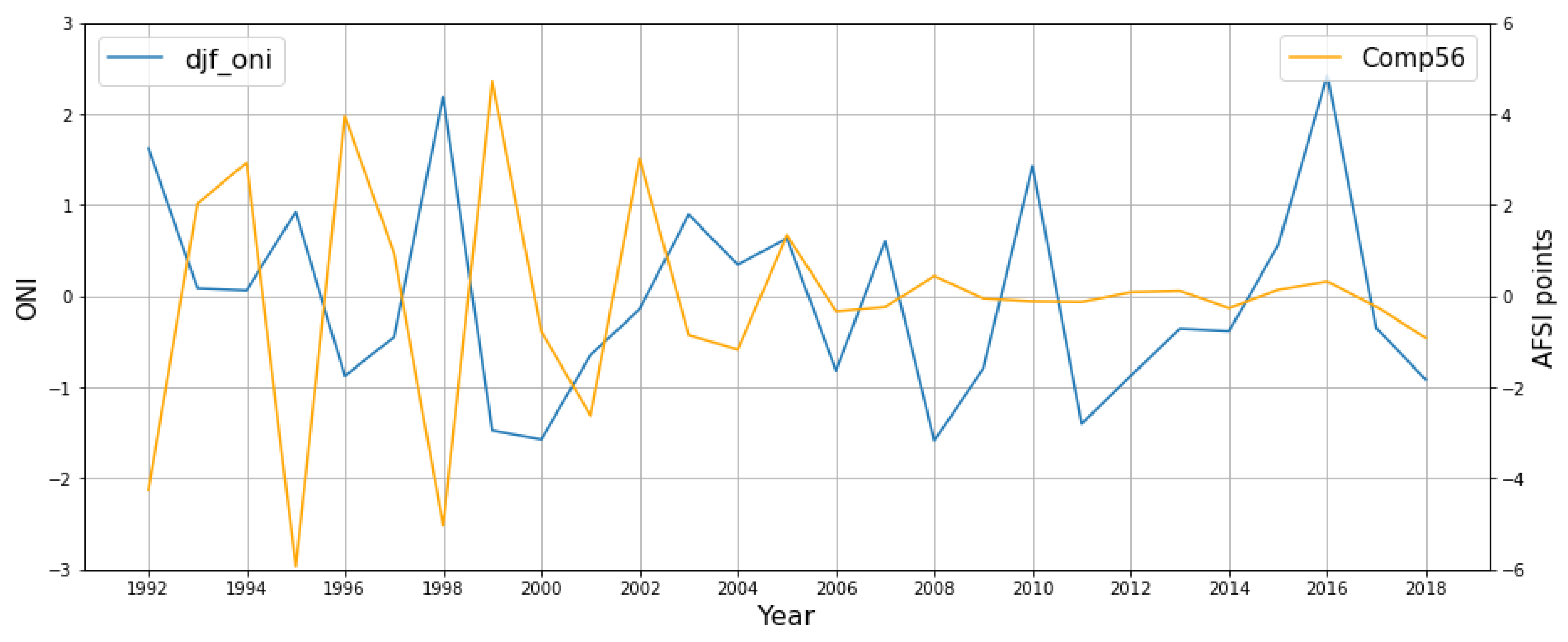
| Principal Components | Characteristic | Variance (%) | Non-Trend Variance (%) | Total Variance (%) | |
|---|---|---|---|---|---|
| AFSI | 0 | Trend—linear | 91.15 | - | 99.71 |
| 1–2 | Periodic (14–15 years) | 4.91 | 55.48 | ||
| 3–4 | Periodic (5–6 years) | 2.39 | 27.01 | ||
| 5–6 | Irregular periodic (2–3 years) | 0.98 | 11.07 |
Disclaimer/Publisher’s Note: The statements, opinions and data contained in all publications are solely those of the individual author(s) and contributor(s) and not of MDPI and/or the editor(s). MDPI and/or the editor(s) disclaim responsibility for any injury to people or property resulting from any ideas, methods, instructions or products referred to in the content. |
© 2023 by the authors. Licensee MDPI, Basel, Switzerland. This article is an open access article distributed under the terms and conditions of the Creative Commons Attribution (CC BY) license (https://creativecommons.org/licenses/by/4.0/).
Share and Cite
Bleiman, B.; Rolinski, T.; Hoffman, E.; Kelsey, E.; Bangor, D. Refining Fire–Climate Relationship Methodologies: Southern California. Fire 2023, 6, 302. https://doi.org/10.3390/fire6080302
Bleiman B, Rolinski T, Hoffman E, Kelsey E, Bangor D. Refining Fire–Climate Relationship Methodologies: Southern California. Fire. 2023; 6(8):302. https://doi.org/10.3390/fire6080302
Chicago/Turabian StyleBleiman, Benjamin, Tom Rolinski, Eric Hoffman, Eric Kelsey, and David Bangor. 2023. "Refining Fire–Climate Relationship Methodologies: Southern California" Fire 6, no. 8: 302. https://doi.org/10.3390/fire6080302






